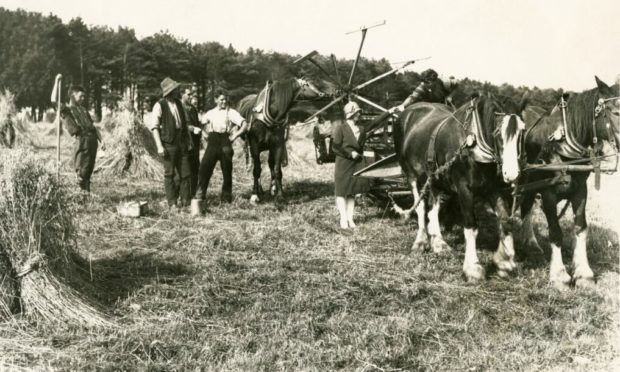Tractors and combine harvesters will be a familiar sight across the north-east over the next few weeks as farmers toil in the fields gathering the harvest.
In warmer climes south of the border, the arable harvest started in July, but farmers in Aberdeenshire will be watching the weather, poised, ready to roll the combines into action.
The harvest, or hairst, is the busiest time of year for farmers, with so much at stake and so much dependent on perfect ground and weather conditions.
It’s been a stop-start harvest for many so far, but farmers will be anxiously watching the sky and hoping for a good yield after a challenging year.
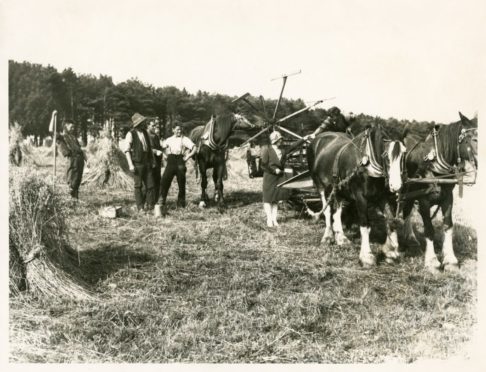
In the early 20th Century, heavy horses helped with the back-breaking load at harvest time.
In this this scene of 1920s Aberdeenshire, these Clydesdales help pull a horse-drawn reaper-binder, which would cut small-grain crop and tie the stems into small bundles, or sheaves.
The sheaves would then be stooked in fields, like small teepees, to allow the grain to dry before being threshed.
In previous years, fields would be littered with farmworkers cutting and binding by hand.
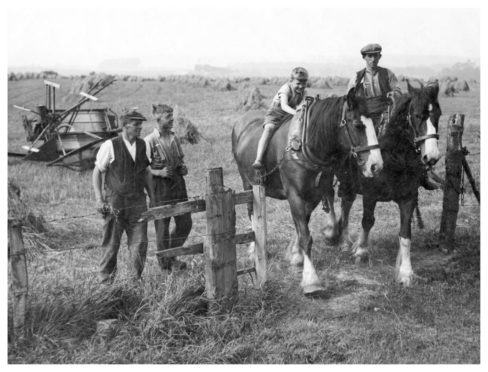
Before the days of modern machinery, it would be all hands on deck for the hairst; young and old, men and women alike, there was a job for everyone.
This young lad no the horse isn’t quite tall enough to reach the stirrups in this pastoral picture from the harvest at Nether Cailie Farm, Aberdeenshire, in August 1939.
It could be an insecure life for farm servants, single men would often spend six months helping at one farm before moving on to another.
And life was no less disruptive for married cottar men seeking work, they would up sticks and move once a year, often when the harvest was over in September.
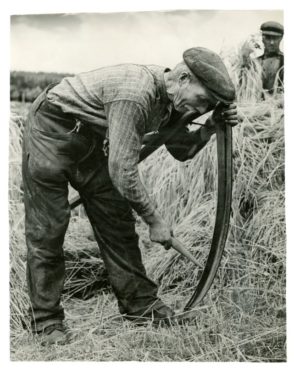
Sometimes the old ways are the best – William Still of Burnhead near Clinterty was keeping the traditional technique of scything alive in August 1948.
Here he pauses to put a sharpened edge on the scythe before tackling another flattened stretch of barley.
The scythe could be a useful tool in difficult-to-access areas where other equipment had difficulty, such as steep slopes.
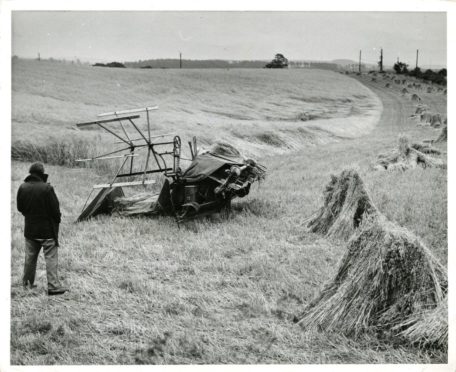
It’s easy to have a romantic view of harvest time when you see combines rolling up and down golden fields in the sunshine, with the beautiful Aberdeenshire countryside as a backdrop.
But with only a very short window to harvest the grain after it reaches maturity and the ideal moisture levels, rainfall can spell disaster.
In this photo from September 1963, harvest operations were at a standstill at Park on Lower Deeside with half the crop flattened and sodden.
Sudden heavy rain could lay fields almost flat making them night on impossible to cut.
There was little that could be done here in the face of unpredictable weather than wait for the grain to dry out and survey the damage.
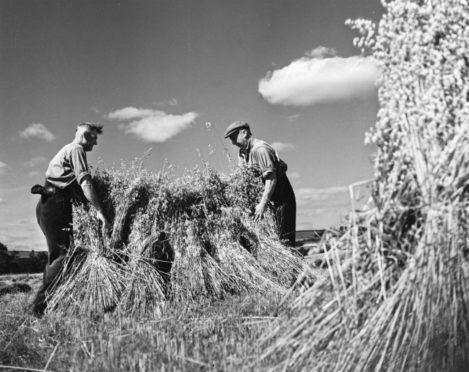
It was a different story two years later in August 1965 at a sunny Dalmaik Farm near Drumoak.
Farmer Alfred Hunter, right, stooks Golden Rain oats in a 10-acre field with the help of Sandy Florence.
The Hunters had gained a reputation for their early crops, but said: “We are usually lucky with the weather in this part of the country. We just hope the good weather continues until the harvest is over.”
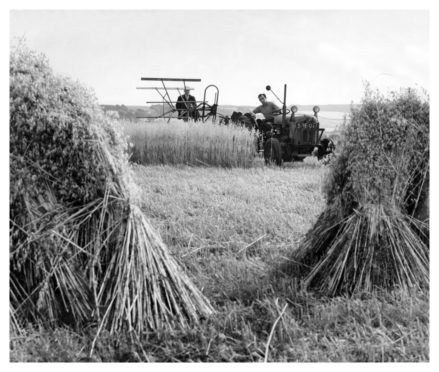
It was an early start to the harvest too at farmer John Gaddie’s farm in August 1967.
Bill Wylie was driving the tractor here as Farmer Gaddie took care of the cutting at Batchart Farm, Blairs, in Deeside.
The farm was located on the picturesque banks of the River Dee beside the old Bieldside ferryboat landing at Blairs.
In the 1950s, Batchart farmhands would often catch the Ferry Belle across to the north bank to catch the bus to Aberdeen.
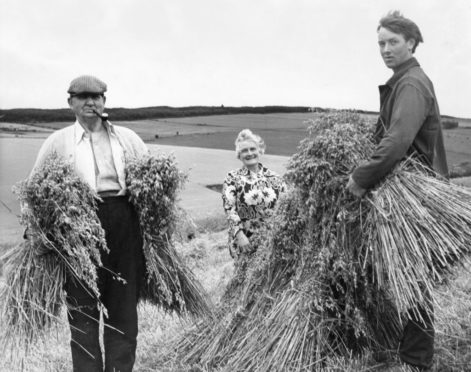
By the 1970s, hand stooking in the harvest field was becoming a rarer sight as advances were made in machinery.
But in September 1978, Sandy Michie and Greta and Jimmy Cowie were busy stooking armfuls of grain at Mill of Backmill by Turriff.
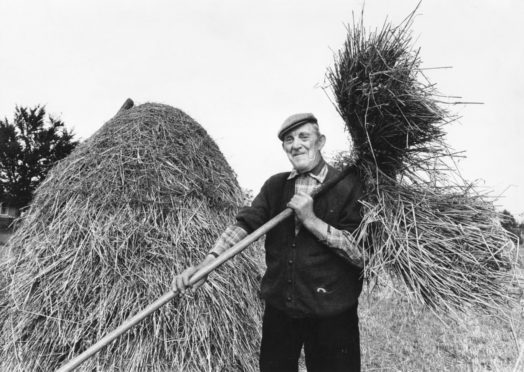
With a pitchfork in hand, James Brown built stacks to stop the oats being scattered during the harvest in 1980.
The spritely 91-year-old hailed from Kendal Road in Kemnay, but had links with farms at Little Forgue.
James went on to live to the grand old age of 105.
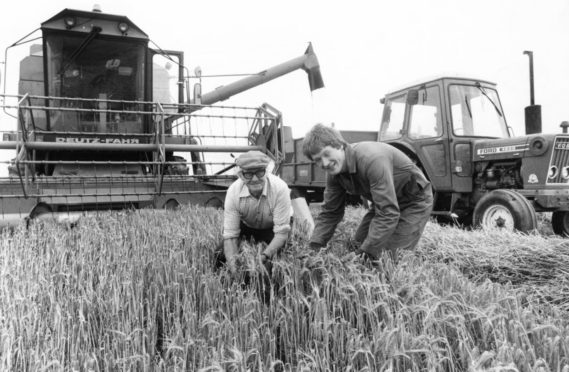
Long gone were the days of hand or even horse-drawn binders in the 1980s, as combines were king.
Combine harvesters cut the crop, thresh it and separate the grain from the straw before expelling the waste straw out the back.
Warm, sunny weather created the perfect conditions for harvest in Aberdeenshire in late August 1982, and combines were out in force across the region.
Tom Shepherd of Pitmillan, Newburgh, and tractorman Norman Riddell paused operations to examine the crop of spring barley.
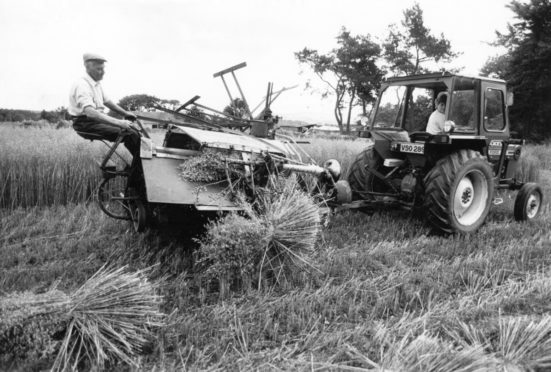
Despite the labour-saving equipment and advent of the combine, the old ways prevailed in some parts of Aberdeenshire.
A sight from a bygone era. William Leiper from Farview Farm at Hill of Kintore used one of the last binders in the north-east during the hairst in September 1988.
Here he is seen reaping with the help of his daughter Edna as the binder delivered the corn in neat bundles for stooking.
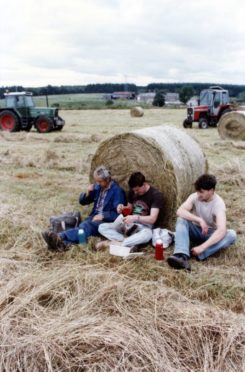
These loons were taking a well-earned break from their work on the summer harvest at Colthill Farm at Countesswells in 1992.
Angus Leslie of Inverbervie, Peter Hogg of Keith and Mark Fleming of Countesswells certainly enjoyed a more comfortable experience than their predecessors in previous years.
The covered tractors could deal with all weathers and even featured their own stereo music, while the hay was rolled tightly into secure bales with the help of machinery.
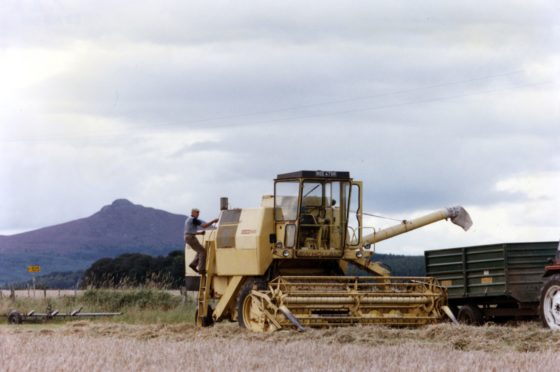
This quaint scene from August 1992 shows farmer Jim Riddell checking his combine as he harvested his barley at Nether Coullie near Kemnay.
There must be fewer picture-perfect locations than a farm in the shadow of Bennachie, the Garioch’s most striking landmark.
In days gone by the end of harvest would be marked with a hairst dance, but a farmer’s work doesn’t stop, come September, drilling and sowing of the winter crop begins.
